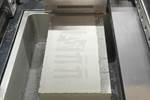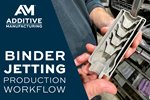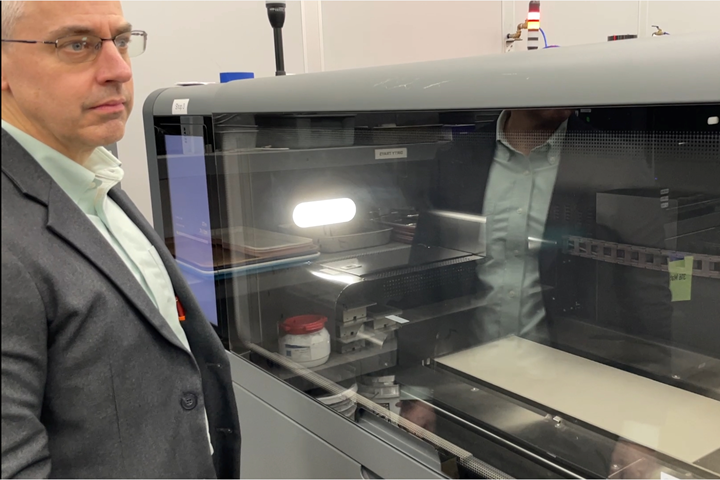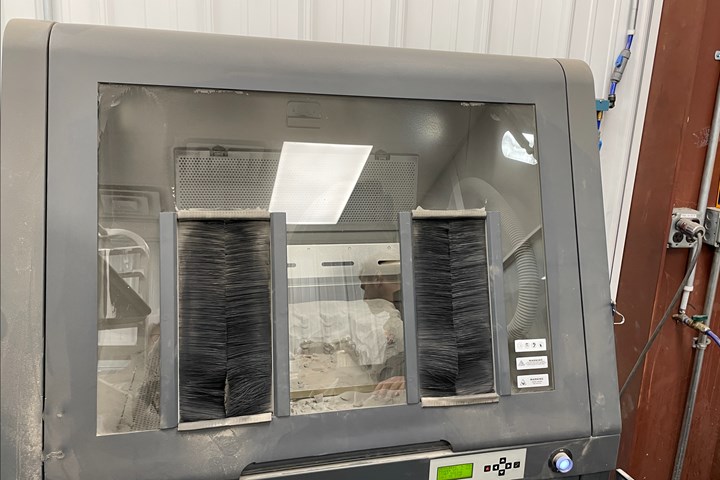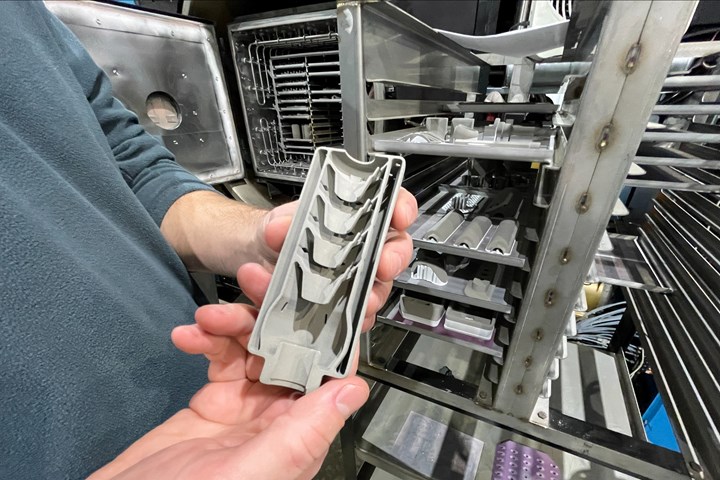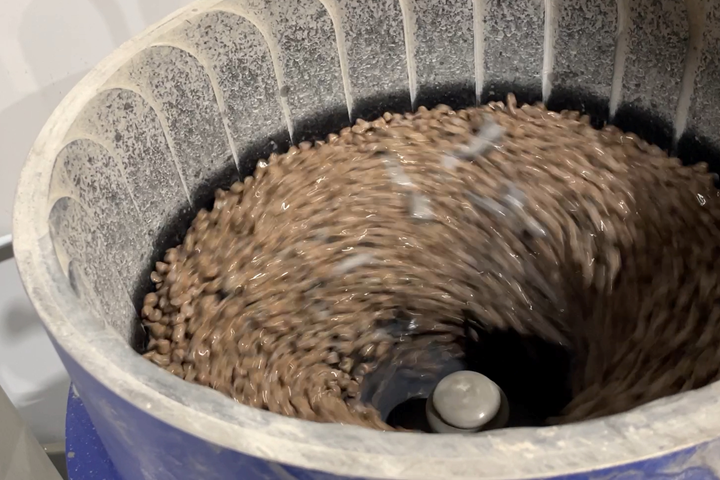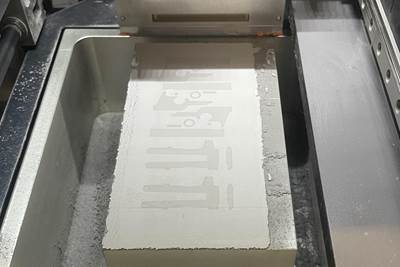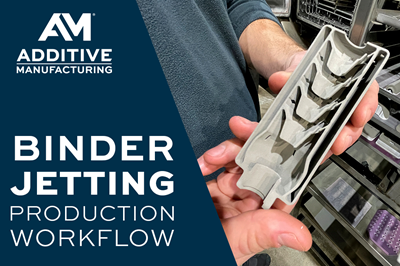Additive manufacturing is a digital manufacturing process, but that does not mean the digital part file is enough of a starting point to begin. Nate Higgins and Chris Aiello believe there ought to be much more: a detailed conversation around the aims for the part and the choices affecting it. That is, what are the important functions of the part, and can any features be adjusted for the sake of greater manufacturing speed or reduced cost? In this respect, they say, additive manufacturing is like manufacturing in general.
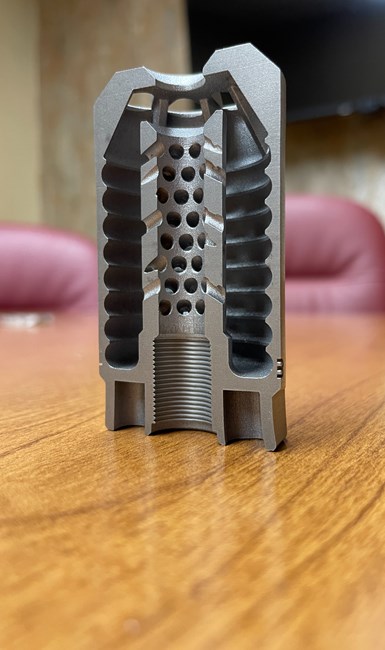
The muzzle brake is a former assembly, formerly joined through welding, now manufactured in one piece via binder jetting. This part has been cut in half to reveal the internal geometry.
In fact, in a whole lot of ways, production AM is like industrial production as we have long understood it, they say. Or it should be. That insight is the principle underlying the manufacturing business these two men founded, and have led for four years. Freeform Technologies, headquartered in St. Mary’s, Pennsylvania, is a contract manufacturer launched to deliver part production via binder jetting, and has since expanded into other metal powder- and sinter-based production processes as well.
Higgins is the president. AM is a disruptor, he says, but it doesn’t disrupt the basics. “Just because we have additive, we shouldn’t be blowing up Kaizen, 5S and Lean Manufacturing,” he says. “The fundamentals are valuable.” What this means for Freeform, in practice, is that instead of adapting production methodology to additive, the company has adapted additive to production methodologies. For example, the binder jetting machines are serviced according to a predictive maintenance schedule the company devised itself, drawing on experience with PM schedules for longer-established equipment types such as molding presses. Also, the company’s very choice of binder jetting machines departs from what some would see as the machine type that would be ideal for production, because the Freeform team has come to a different view as to what type of machine fits the needs and pacing of how industrial production ought to flow.
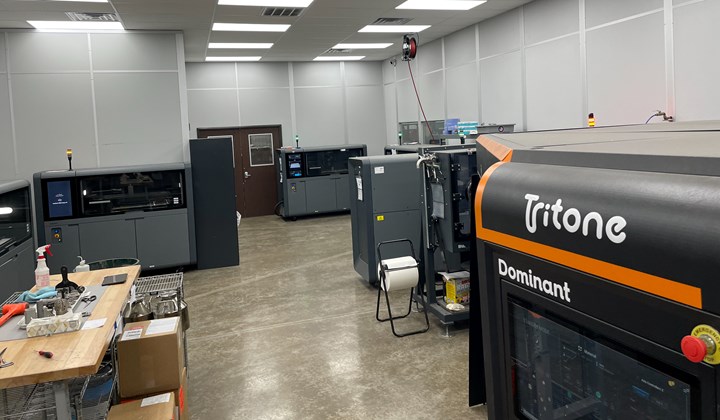
Freeform's capabilities in St. Mary's include binder jetting, mostly on Desktop Metal Shop machines (seen in the background) and a Tritone MoldJet system delivering an alternate mode of sinter-based metal AM.
Recently, the company’s binder jetting capacity expanded considerably. The founders saw an opportunity to acquire the binder jetting part-making facility formerly run by ExOne (now part of Desktop Metal) and bring their industrial production methodology to this site. Thus, the headquarters site in St. Mary’s, which runs six binder jetting machines plus three metal injection molding (MIM) presses and a MoldJet sinter-based additive system from Tritone Technologies (more on this in a bit), has now been joined by a sister location in Pittsburgh running 16 binder jetting machines.
I went to St. Mary’s to walk through the company’s process and spend time on the production floor with the two cofounders. Freeform is in daily production with AM, now serving about 10 to 12 active customers at any given time that each rely on the company for AM part numbers in quantities of 100 to 1,000 pieces per month. About 50 upcoming part-production opportunities at this scale are also in development. As a result, even though the facility also does MIM for higher-quantity work, the sintering furnaces are typically filled with additive parts.
Walking the floor gave a sense of what this work is like. Compared to most other part-making processes, AM is quieter and lower in labor (save perhaps for depowdering, the one potentially labor-intensive step). Other than these differences, in terms of rhythm and repetition, the feel of production at Freeform is … well, like production.
Here is more on what the company set out to build, and on the system and procedures they have developed so far:
How to Adapt a Part to Binder Jetting
Aiello is the VP of business development. He and Higgins founded the business in 2020. Both came from working in MIM, and both were fascinated by the promise they saw in binder jetting. “No one was taking a traditional approach to this non-traditional process,” he says. The company began with two binder jetting machines: a P1 from Desktop Metal and an Innovent from ExOne. All later machines at St. Mary’s have been Desktop Metal’s “Shop” model.
Among other things, the “traditional approach” he refers to emphasizes interactions with customers. Nearly every prospective part offers opportunities for cost saving, he says, if only the designer and manufacturer can better understand one another’s needs. Conversation aims to get to this understanding.
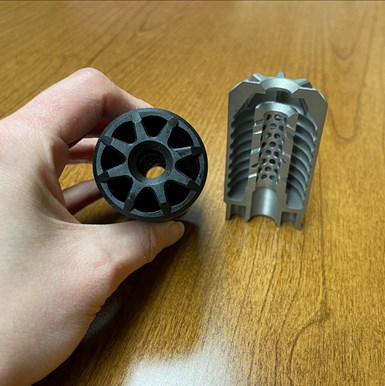
The Freeform team engages in conversations with customers to understand the part's measure of success. If one of them is part consolidation, as in the case of the muzzle brake, then company president Nate Higgins says, “We can win.”
“Wall thicknesses, radii, chamfers — these are the kinds of things we ask about,” Aiello says. In binder jetting, initially printing any form or feature might be straightforward, but design modifications to any of these features might produce more controlled or consistent outcomes in sintering, which is a vital and generally underappreciated part of the binder jetting process. Similarly, if there are many critical features on the part, how these features interact with one another can be important to understand.
This, too, comes down to sintering. Higgins says, “We often ask: Can you give us a flat surface to sinter on?” If a part can rest on its own surface within the oven, this saves Freeform from creating a tool to support it, and this can deliver cost savings that are considerable.
He continues, “We always want to understand how we will measure success. If the aim is lightweighting, or assembly consolidation, or speed to market, then we can win.”
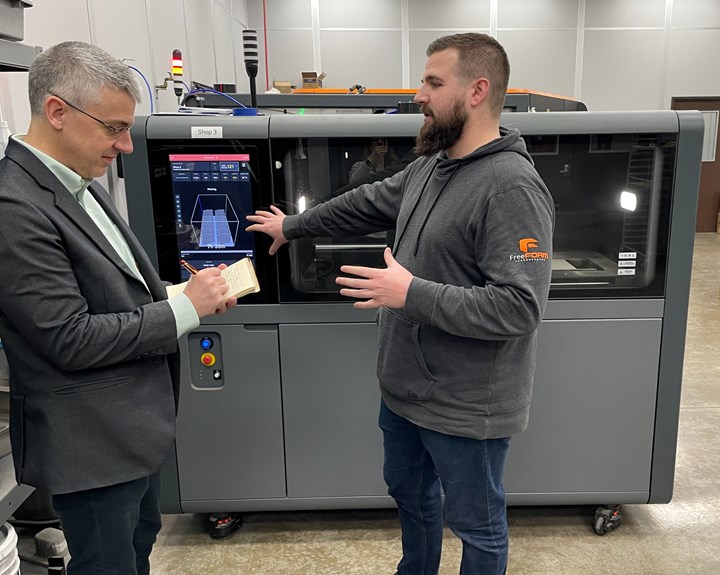
Binder jetting makes it possible to nest parts to 3D print batches of components at once, but there are limits. Company VP Chris Aiello explains: Because this is production, like parts are all oriented in the same direction. To do otherwise would introduce a variable that might make one production part different from another.
Parts With Fewer Pieces, More Variety
The industries the company now serves include defense, medical and industrial machinery, as well as various narrower markets. For example, one component I saw in production (details are proprietary) relates to a forthcoming new product for the food service industry.
Another sector is firearms. One production part the company runs that was redesigned for additive is a firearm muzzle brake. Formerly the part was an assembly consisting of the muzzle brake geometry plus a tube, cap and nut, all welded together. Binder jetting is not cheaper than any one of these pieces alone. However, binder jetting proved significantly cheaper than the assembly. 3D printing the former assembly as one solid unit saves the customer the cost of sourcing and assembling the components.
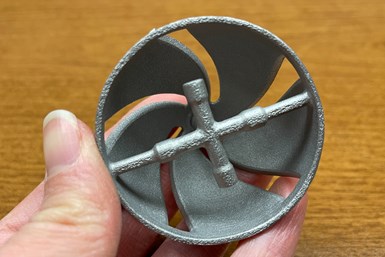
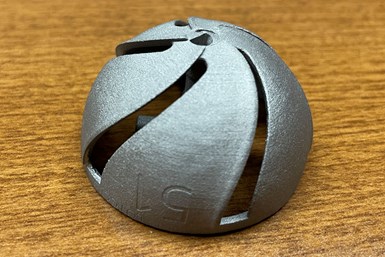
This surgical reamer was previously made through stamping. It still could be made that way, except the provider wants to offer many more size varieties. If the reamer proceeds to full production, which Freeform expects, parts will be 3D printed via binder jetting in mixed sizes, according to which sizes are needed. This kind of nimbleness favors AM, and it also speaks to why Freeform has built its AM process around smaller-capacity machines delivering production it can turn more quickly.
In addition to assembly consolidation, part variety is another reason additive wins. An example here is a surgical reamer used to prepare patients for acetabular hip implants. The reamer is traditionally made through stamping, in just a few different sizes for the tool, but the OEM wants to offer reamer size options in every 1-mm increment of diameter to better tailor the tool to each patient. That many reamer sizes would mean too many stamping dies to be economical, so binder jetting is the cost-effective choice. The tool has not yet entered production, but when it does, the goal is to produce 10,000 per year. The catch is this: Reamers will be made essentially on demand, so any build might contain any mix of different reamer sizes. This kind of variable production batching argues for additive, because a stamping process would have to run many identical pieces before changing the die.
Freeform says the desire to offer this kind of production nimbleness was one of the factors that informed its choice of binder jetting platform.
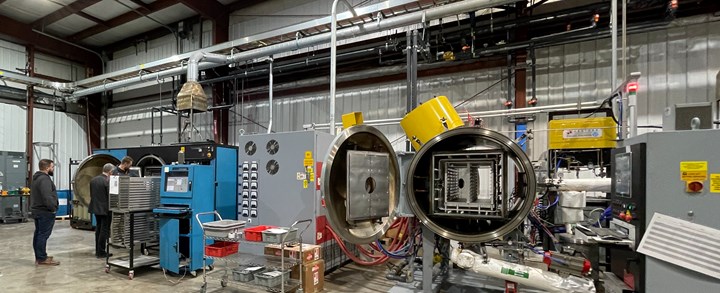
Sintering furnaces do not run every day. Capacity is larger than a day's additive production, large enough sometimes to run a month's quantity of multiple AM jobs at once.
Return on Turns: The Case for Smaller AM Build Volume
The St. Mary’s facility relies largely on the Desktop Metal “Shop” system, running five of these machines and dedicating different machines to different metals. The maker of this machine model introduced it with the idea that it might be a natural metal 3D printing option for CNC machine shops. Freeform’s leaders see it as something different: their preferred platform for additive production. While other binder jetting machines offer larger chambers able to produce more parts in a single build, Freeform sees the limited build size of its machines (the Shop system is available in sizes up to 16 liter, but Freeform does not use the largest model) as an advantage instead of an impediment.
“Eight- to 10-liter build size is the sweet spot for our work,” Higgins says. “For us, bigger build volume does not yield more return. More turns are what yield us more return.”
On the Shop machines, he says, one build — including 3D printing, curing, depowdering and sintering — can be turned in five days. A bigger build envelope would allow more pieces to be 3D printed in one batch. However, turn time would then be longer, and the chance to be responsive for make-to-order opportunities like the hip reamer would be compromised.
Plus, for jobs that call for a larger number of pieces in one run, the company has an option. Contrasted with MIM providers that have expanded into binder jetting as an extension of their capabilities, Freeform presents the very opposite picture. This additive provider expanded into MIM.
MIM, Plus Tritone as “Digital MIM”
Aiello says, “When we got started, we had no interest in providing metal injection molding.” There is a lot of competition, he notes. However, MIM is the right process for certain higher-volume parts. That became apparent almost at once, when one of the company’s very first successes with production binder jetting scaled in exponential steps. The first order for the part was five pieces, then after a design change came an order for 50, then after another design change was an order for 500 more. The product proved successful, so that the customer’s need soon rose to 50,000 per month — far too much for Freeform’s AM capacity to keep up with. The team knew someone would make the parts through MIM. Aiello says, “We have the furnaces and the sintering expertise,” and he notes that the company’s additive production jobs often specify MIM material standards, so this is the realm in which they were already working. “So we said OK to MIM,” he says. Today, there are six recurring MIM customers, enough to support three presses.

Higgins notes the value of the Tritone MoldJet system is in depowdering, sometimes a weakness of binder jetting. MoldJet 3D prints a mold for the powder metal as part of the process. The capability is relatively new for Freeform, but the company has already discovered some additive parts it can only produce on this machine because of the way part geometry inhibits powder removal.
Another important capability expansion has involved a process different from MIM, albeit not entirely: the “MoldJet” process from Tritone. Freeform has a Tritone machine in St. Mary’s running alongside its binder jetting systems. The process is, in a sense, “digital MIM,” says Higgins, because the multi-station carousel machine works by 3D printing a mold (in wax) into which it applies a blend of powder metal and binder during the same cycle. Each layer of wax plus binder plus metal is hardened as part of the sequence, with the complete wax mold later removed prior to sintering the part it helped to produce. Like MIM, this alternate method of sinter-based AM offers freedom from depowdering, an often-problematic step in binder jetting.
The capability is new for Freeform, but even so, Higgins says the company has already seen “two, maybe three parts that we can only make with the Tritone.” Plus, certain other parts that could be made through binder jetting have proven easier here.
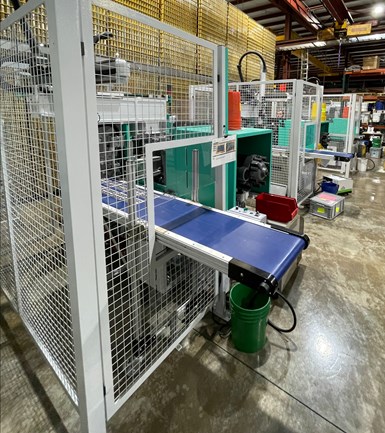
The company runs metal injection molding on three lines. The company did not originally expect to offer MIM, but it proved valuable for supporting some customers scaling to higher volumes. (Unrelated: Freeform's neighbor in its facility is a maker of beer cans. That other company's inventory is visible here.)
In the past, Higgins says, “There were people we were saying no to because we could not see a way to depowder their geometry.” Here as well, conversation with prospects is valuable for identifying the best wins for additive — and having this additional AM capability allows conversations to arrive at yes more often.
More Years Than Weeks: The Ryerson Investment
The very biggest capability expansion came with the purchase of the ExOne part production facility. This also is still new. Higgins and Aiello are mindful of wanting to proceed slowly with integration, to more fully preserve and leverage the possibilities of this site, including the expertise here. The facility offers not just more binder jetting, but also knowledge base — related to multimaterial infiltrated binder jet parts, for example — that represents meaningful new offerings for the company. Yet over time, the two sites will come to operate more and more like one another, as they both are organized around the same fundamental philosophy of production. Freeform hopes the investment in more capacity will bring them more opportunities for conversation with customers that lead to production work.
The assurance of stability is one more foundational element of success in manufacturing that figures in here, the company leaders say — albeit not one that is as quantifiable in its impact as, say, Lean or Kaizen. But stability is a value Freeform has wanted to convey nonetheless. The acquisition and integration of the ExOne site helps with this, but the purchase was possible in part because of an investor that also responded to, and is now helping to reinforce, that stability. In 2022, metal distributor and processor Ryerson became an investor in Freeform. At the time of this investment, Aiello notes, the larger company had more years in business that Freeform had weeks. Ryerson, with about 100 locations and about 4,000 employees, was founded in 1842.
“They understood that we are not trying to flip this company in five years,” Aiello says. The investment brings capital and guidance, and helps convey the same point about long-term ownership to potential production customers. Thus, Freeform’s reward for looking and operating more like an industrial enterprise, and less like a technology startup, has been to win the validation and support of a larger and older industrial enterprise.
Higgins says, “During their first visit, they took a look around and said, ‘At least you guys don’t have a ping pong table.’”
Related Content
How Norsk Titanium Is Scaling Up AM Production — and Employment — in New York State
New opportunities for part production via the company’s forging-like additive process are coming from the aerospace industry as well as a different sector, the semiconductor industry.
Read MoreDMG MORI: Build Plate “Pucks” Cut Postprocessing Time by 80%
For spinal implants and other small 3D printed parts made through laser powder bed fusion, separate clampable units resting within the build plate provide for easy transfer to a CNC lathe.
Read MoreHow Machining Makes AM Successful for Innovative 3D Manufacturing
Connections between metal 3D printing and CNC machining serve the Indiana manufacturer in many ways. One connection is customer conversations that resemble a machining job shop. Here is a look at a small company that has advanced quickly to become a thriving additive manufacturing part producer.
Read MoreBeehive Industries Is Going Big on Small-Scale Engines Made Through Additive Manufacturing
Backed by decades of experience in both aviation and additive, the company is now laser-focused on a single goal: developing, proving and scaling production of engines providing 5,000 lbs of thrust or less.
Read MoreRead Next
AM 101: What Is Binder Jetting? (Includes Video)
Binder jetting requires no support structures, is accurate and repeatable, and is said to eliminate dimensional distortion problems common in some high-heat 3D technologies. Here is a look at how binder jetting works and its benefits for additive manufacturing.
Read MoreVideo: Binder Jetting Production Workflow at Freeform Technologies
Additive manufacturing via binder jetting includes a sequence of downstream steps. During a visit to the Pennsylvania metal 3D printing part producer, I had the chance to walk through this process.
Read MorePostprocessing Steps and Costs for Metal 3D Printing
When your metal part is done 3D printing, you just pull it out of the machine and start using it, right? Not exactly.
Read More


